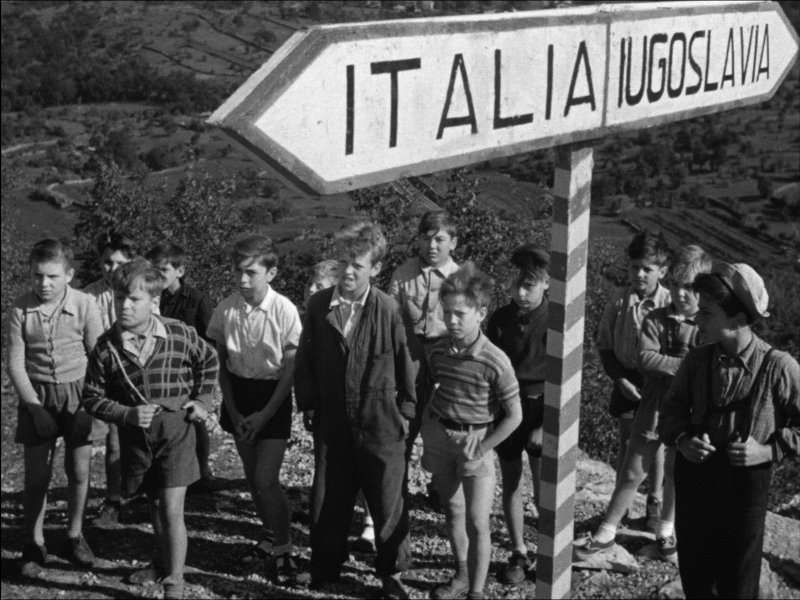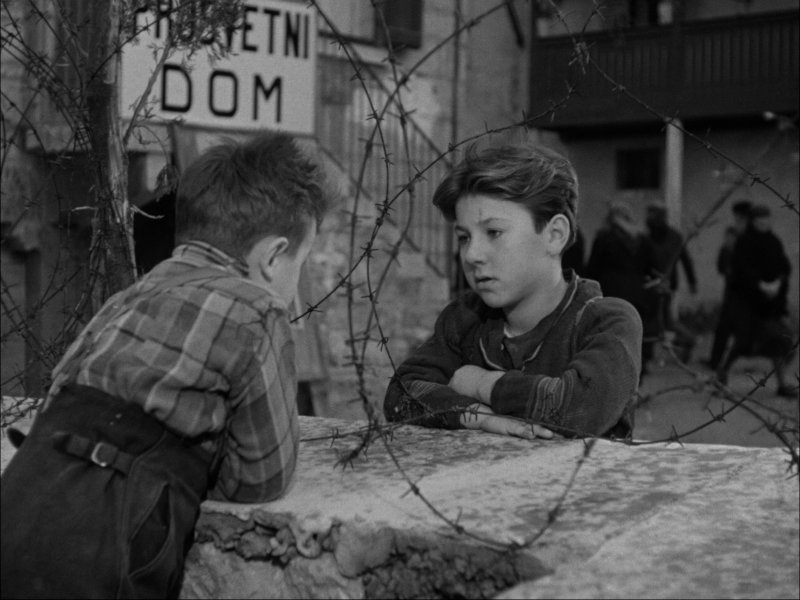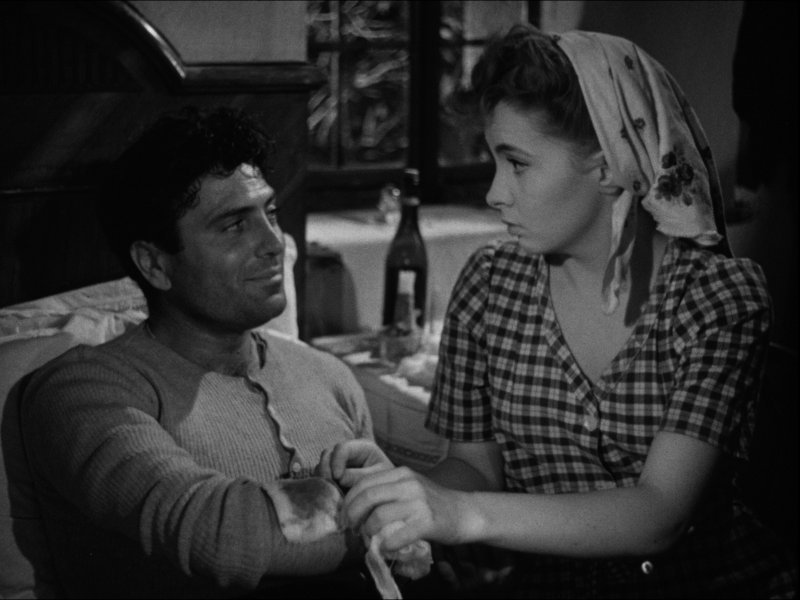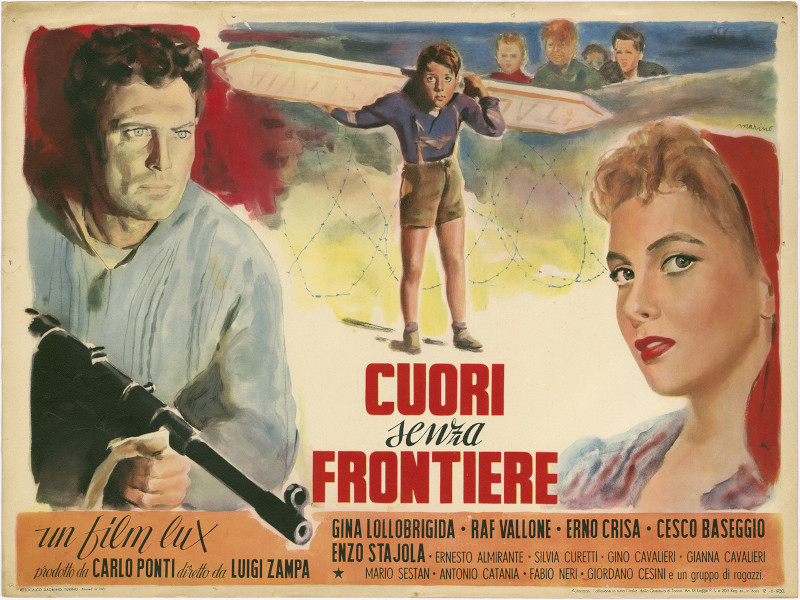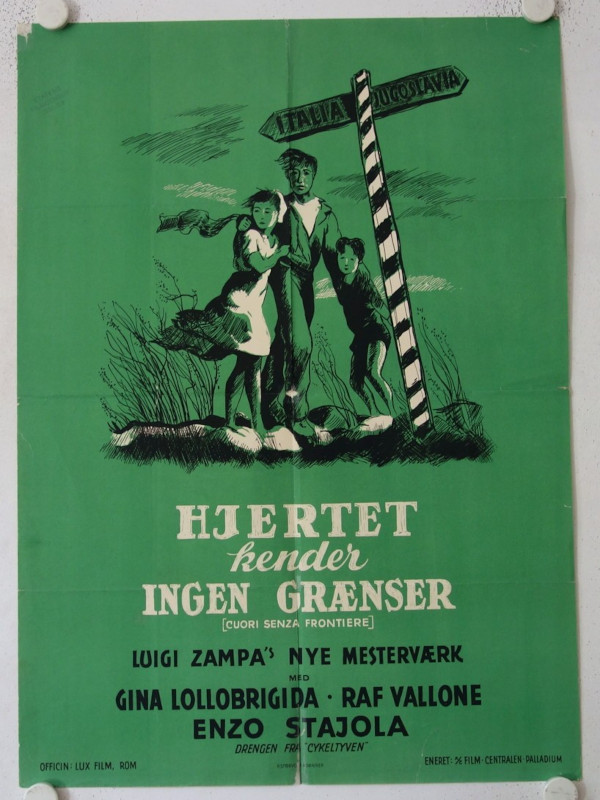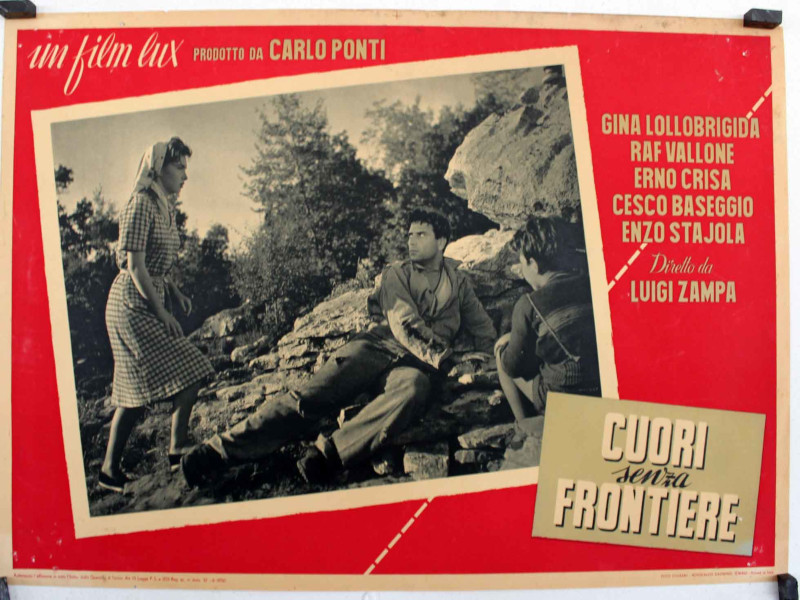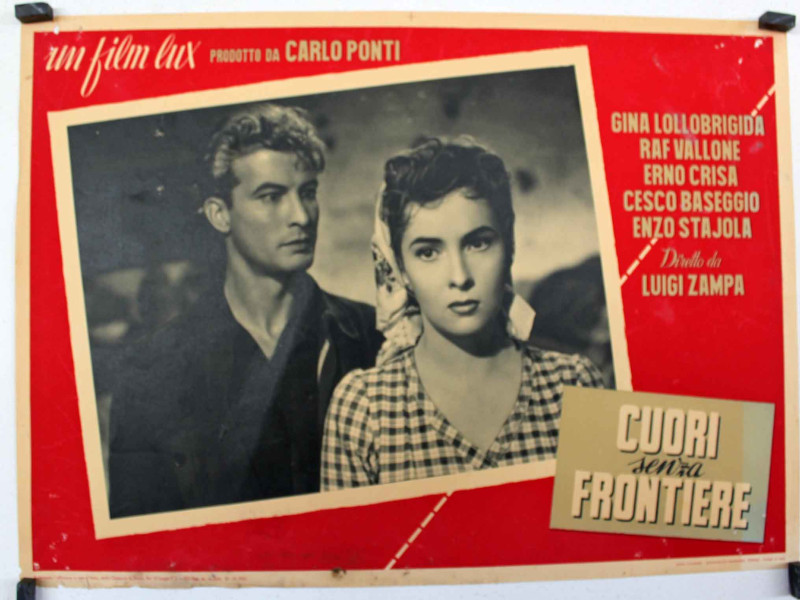Hearts without Borders (1950)
The White Line
Cuori senza frontiere [ITA]
In a small village a state border between Italy and Yugoslavia is suddenly imposed.
- Film kind: feature fiction, melodrama
- Duration: 87’
- Year: 1950
- Country: ITA
- Format: 35 mm, black and white
- Language: Italian
- Director: Luigi Zampa
- Script: Piero Tellini, Stefano Terra
- Cinematography: Carlo Montuori
- Editing: Eraldo da Roma
- Music: Carlo Rustichelli
- Scenography: Aldo Buzzi
- Production: Lux film
- Cast: Gina Lollobrigida, Raf Vallone, Cesco Baseggio [ITA], Erno Crisa, Ernesto Almirante, Enzo Stajola, Callisto Cosulich, Gino Cavalieri, Tullio Kezich [ITA]
- Film festivals: Venice Film Festival (the 1st Mostra Mercato Internazionale del Film, Italy, 1950), Torino Film Festival, i.e. 7th Festival internazionale cinema giovani [ITA] - Retrospettiva: Il neorealismo in cinquanta film (Torino, Italy, 1989), Il cinema ritrovato (Cineteca di Bologna, Italy, 2006), Festival internazionale del film di Roma [ITA], 2009.
- Other screenings: special screening in Casa di cultura - Dom Albert Sirk in Santa Croce [ITA], (Trieste, Italy, June 19, 2017), screening in the Civico Museo Sartorio [ITA] (Trieste, Italy, November 22, 2018, "Oriente / Occidente - la frontiera nel cinema e nella storia 1945-1954-2025" [ITA] traveling conference (Palazzo del cinema, Gorizia, Italy, May 13, 2022), special screening in Piazza Transalpina [ITA] / Trg Evrope, Gorizia, July 22, 2022), Luigi Zampa’s retrospective [FRA], Cinémathèque française (Paris, France, January 31 and February 21, 2016), etc.
Videogallery
Photogallery
Film stills
Film posters
Long synopsis
In a small village in the Carso [Kras] region a state border between Italy and Yugoslavia is suddenly imposed. The villagers need to make an urgent decision on which side of the border they want to live on. A group of local children find a way to cope with the new situation. The situation is more complex among adults, and a love story is interrupted when the male partner chooses to settle in Yugoslavia for political reasons.
Festival circulation
"Cuori senza frontiere" was shown at the Venice film festival in 1950 as a part of the first international film market exhibition (Mostra Mercato Internazionale del Film). Although its festival life initially ended with this screening, the festival interest in this film has been renewed in contemporary times. In 1989, it was shown at the Torino film festival (at the time called Festival internazionale cinema giovani) as a part of a retrospective Il neorealismo in 50 film [ITA] [Neorealism in 50 Films]. Following the film’s restoration in 2000, it was also screened at the Il Cinema Ritrovato festival organised by the Bologna Film Archives (Cineteca di Bologna), in the section The Mise-en-scène of the Cold War. In addition, it had numerous screenings in various special events in Trieste, Gorizia and the surrounding area, as for instance in the art museum Museo Civico Sartorio in Trieste [ITA] (2018), and in Palazzo del cinema [ITA] in Gorizia (2022). In July 2022, it was shown in Piazza della Transalpina [ITA] (Trg Evrope [SLV], Europe Square [ENG]), a square shared by the towns of Gorizia and Nova Gorica, and thus by the states of Italy and Slovenia. (Between 1947–1991 Piazza della Transalpina hosted the checkpoint between Italy and Yugoslavia.) It was also screened in the cultural centre Albert Sirk in the community of Santa Croce (Križ [SLV]), as a symbolical return to one of the film’s main shooting locations (2017). Finally, it is regularly shown within retrospectives of Zampa’s work, such as the ones organised by the Festival internazionale del film di Roma [ITA] in 2009, and by the Cinémathèque française [FRA] in Paris in early 2016.
Media and public interest
When the film came out the reviews in the Italian press were correct, although it was criticized for lack of solidity (Ezio Colombo, "Prime visioni", "Bis", No. 42, October 21, 1950) and continuity ("Segnalazioni cinematografiche" [ITA], Vol. 28, 1950), as well as for not being very convincing (Vice, “Cinema”, No. 49, Novembre 1, 1950). Despite this, it was complimented for good camerawork and for “condemning lies, hatred and falsehood” ("Segnalazioni cinematografiche", Vol. 28, 1950). The reviews in the Yugoslav press were quite different, and the film was harshly criticized as a “deliberate provocation” cooked up by the Soviets (cf. “Film u službi međunarodne provokacije”, Filmska revija, No. 1-2, March/April 1950). The establishment of Giorno del ricordo in Italy in 2004, and an increased relevance accorded to the issue of the northern Adriatic border have sparked renewed interest in this film. Its visibility in the media has thus also been increased, typically in the texts that announce and comment on the scheduled screenings (see for instance the article published by "Messaggero Veneto", February 8, 2010, available on the website of Cineteca del Friuli [ITA]).
About the filmmaker
Italian filmmaker Luigi Zampa (1905-1991) experimented with various film types but is best known for his neorealist filmmaking. From 1932 to 1937, he studied screenwriting and directing at the Centro Sperimentale di Cinematografia in Rome. During his early years, he made military training films for the Italian army. After the war, he made several acclaimed films inspired by WWII, such as Vivere in pace (1947), a tragicomedy about the absurdity of the war. Anni difficili (1948), a comedy about fascism, was the first in a series of films in which he portrayed the phenomena of cowardice and opportunism [FRA] in the Italian society (for instance: L’Arte di arrangiarsi ["The Art of Getting Along", 1954], Ladro lui, ladra lei ["He a Thief, She a Thief", 1958], Gli Anni ruggenti ["Roaring Years", 1962], etc.). Throughout the 1960s he remained focused on comedies about the human nature and the (lack of) ethics (for instance Una questione d’onore ["A Question of Honor", 1966], Il medico della mutua ["Be Sick… Its Free," 1968]). In the 1970s his filmmaking became more pessimistic, as evidenced from the dramas Bisturi, la mafia bianca" "["Secrets of a Nurse" a.k.a. "Hospitals: The White Mafia", 1973], and Gente di rispetto ["The Flower in his Mouth", 1975], and the thriller Il Mostro ["The Fiend," 1977]. Zampa’s final film was Letti selvaggi ["Tigers in Lipstick", 1979], a comedy combining eight unrelated stories, each involving an attractive woman, played by Ursula Andress, Laura Antonelli, Sylvia Kristel and Monica Vitti (The four lead actresses starred in two episodes each.) Zampa dieed in Rome in 1991 at the age of 86.
NB: in the short documentary Cuori senza frontiere, ricordi/spomini (Hearts without Boundaries, Memories, ITA, 1999), filmmaker Martina Kafol gathered the actors who played the children in Cuori senza frontiere. Together with the locals from the village where the film was shot they remember its making of.

